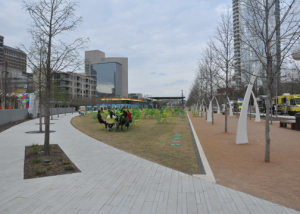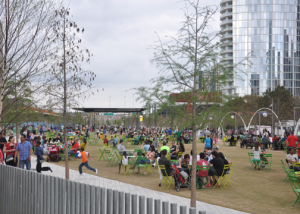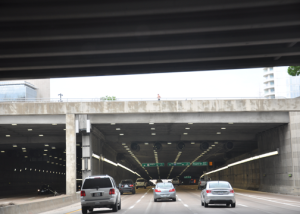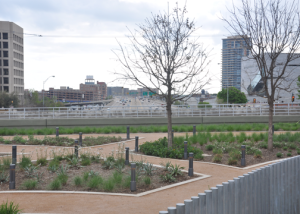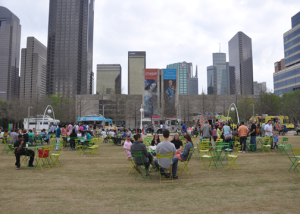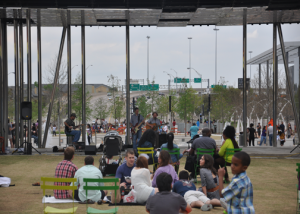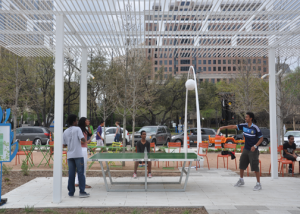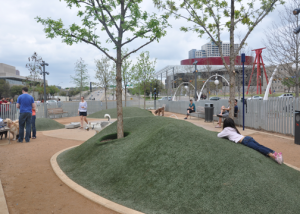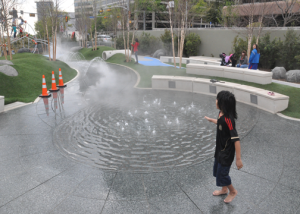Once a sunken freeway which divided the city into north and south districts, the Klyde Warren Park repairs this former urban scar by literally capping the Woodall Rogers freeway with a concrete structure completed in 2012. It is the latest of parks which cover portions of a freeway much like at the Big Dig in Boston. Yet unlike in Boston, the 5.2 acre park is actively used and the residents seem to really enjoy themselves there. Located adjacent to the developing Arts District, it spans 3 city blocks with an active road dividing the park into two parts as well as perimeter roads encircling the park. The Museum of Modern Art, Nasher Sculpture Center, Performing Arts Theater, and Symphony Hall face or back onto the length of this space on one side and on the other side there is developing luxury housing which borders the uptown district. On the ends of the park, the freeway is seen far below the park level on one end and on the other the freeway soars upward. Because of its relationship to the freeway, one has the strong sense that something unusual has taken place- that the space that was not meant to be but through human re-intervention exists and is therefore something to be celebrated. It seems to have become the central heart of the city. People seem to feel at home in this space, uninhibited to partake in activities offered there or bringing their own as if the space belongs to everyone. The park operates more like a public central square rather than a lush park landscape where all types of public life takes place for individuals and groups- picnicking, board game playing, general socializing, reading, children play at a dedicated playground, frisbee, football, soccer, mini golf, ping pong, crochet, petanque, and yoga. There are also organized events such as a fitness bootcamp, strolling walking, and knitting circle, and local concerts. Bright white concrete paving invites visitors in from the street corner and draws them around the central lawn. On the main lawn, colorful cafe tables randomly and freely distributed allow one to inhabit the space despite the barely existent lawn which appears more like a thin dirt surface. Food trucks line one of the streets tempting visitors to linger. A special section called the Reading Room offers books on wheeled carts to pass the day. Near one end of the park is a pavilion for staged events and cafe still under construction. The atmosphere of the park is more like a street fair. The vegetation is still growing in and the trees planted only on the main walk ways seem to be suffering, perhaps due to the extreme heat in a concrete bathtub. The sound of the freeway is deafining at the two ends which face the freeway. But as you move toward the middle of the park, you cannot hear the freeway at all. You begin to lose the sense you are actually over a freeway and feel you are in a true public space.
There is an interesting effect as you drive under the park. You see the park as you slip under it. Once under, there is no relationship to above. The traffic is separated by a solid wall. It is well illuminated with exhaust fans which seem to work for when the traffic is at a stand still while under the park. The park deck is made of more than 300 concrete beams. The concrete slab connects the beams at the bottom to create tree trenches. The trees seem to be struggling in these enlarged planter boxes. Perhaps it is due to the amount of heat the concrete absorbs the trees cannot handle while very young.
In contrast, the central road to the arts district appears bleak, absent of street life, especially during the day. The Wyly Performing Arts Center, and Symphony Hall face a shared street, where sidewalk and road blend together has a singled paved surface, in an attempt to create a grand public space much like Exhibition Road in London which fronts the Victoria and Albert Museum. The Performing Arts Theater’s large canopy roof and granite plaza fountain create a cooler microclimate to combat the strength of the sun’s solar radiation and give reason to be there. But it is the lack of day time programming that creates this void. The Nasher and Museum of Modern Art also front this street, but isn’t enough as they are at one end of the two block long road.
When you look at the downtown Dallas fabric, there are many parks the city of one city block scattered throughout the downtown core. Some have been recently completed such as the Bello Gardens and Main Street Garden Park. They do not though seem capable of attracting large crowds. They seem to act more as smaller scale neighborhood parks. Perhaps its’ the lack of a still young though emerging residential component in the downtown historic core.
This project gives one a sense of what a decked park over the 101 freeway in downtown Los Angeles could be.
The park was funded through a public, private partnership and is maintained by the Woodall Rodgers Park Foundation.

